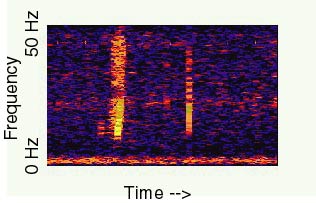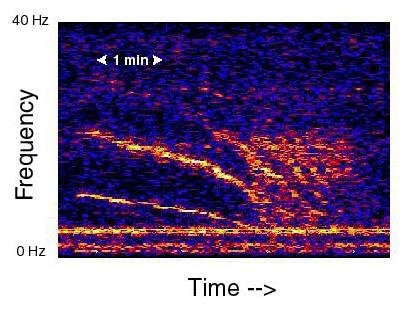Cthulhu fart, 1997
-
<!-- m --><a class="postlink" href="http://www.bloopwatch.org/bloop_realtime_nr.wav">http://www.bloopwatch.org/bloop_realtime_nr.wav</a><!-- m -->
<!-- m --><a class="postlink" href="http://www.pmel.noaa.gov/vents/acoustics/sounds/bloop.wav">http://www.pmel.noaa.gov/vents/acoustic ... /bloop.wav</a><!-- m --> x16<!-- m --><a class="postlink" href="http://www.pmel.noaa.gov/vents/acoustics/sounds/bloop.html">http://www.pmel.noaa.gov/vents/acoustic ... bloop.html</a><!-- m -->
"Bloop"
This sound was repeatedly recorded during summer, 1997 on the Equatorial Pacific Ocean autonomous hydrophone array. The sound rises rapidly in frequency over about one minute and was of sufficient amplitude to be heard on multiple sensors, at a range of over 5,000 km. It yields a general location near 50oS; 100oW. The origin of the sound is unknown.Click on spectrogram for full-sized image.
bloop sound162K wav file(The recorded signal has been sped up 16 times)

<!-- m --><a class="postlink" href="http://archives.cnn.com/2002/TECH/science/06/13/bloop/">http://archives.cnn.com/2002/TECH/science/06/13/bloop/</a><!-- m -->
Tuning in to a deep sea monster
June 13, 2002 Posted: 6:28 AM EDT (1028 GMT)
LONDON, England -- Scientists have revealed a mysterious recording that they say could be the sound of a giant beast lurking in the depths of the ocean.
Researchers have nicknamed the strange unidentified sound picked up by undersea microphones "Bloop."
While it bears the varying frequency hallmark of marine animals, it is far more powerful than the calls made by any creature known on Earth, Britain's New Scientist reported on Thursday.
It is too big for a whale and one theory is that it is a deep sea monster, possibly a many-tentacled giant squid.
In 1997, Bloop was detected by U.S. Navy "spy" sensors 3,000 miles apart that had been put there to detect the movement of Soviet submarines, the magazine reports.
The frequency of the sound meant it had to be much louder than any recognised animal noise, including that produced by the largest whales.
So is it a huge octopus? Although dead giant squid have been washed up on beaches, and tell-tale sucker marks have been seen on whales, there has never been a confirmed sighting of one of the elusive cephalopods in the wild.
The largest dead squid on record measured about 60ft including the length of its tentacles, but no one knows how big the creatures might grow.
For years sailors have told tales of monsters of the deep including the huge, many-tentacled kraken that could reach as high as a ship's mainmast and sink the biggest ships.
However Phil Lobel, a marine biologist at Boston University, Massachusetts, doubts that giant squid are the source of Bloop.
"Cephalopods have no gas-filled sac, so they have no way to make that type of noise," he said. "Though you can never rule anything out completely, I doubt it."
NOAA vessel
Scientists from the U.S.'s NOAA have been baffled by the "Bloop" soundNevertheless he agrees that the sound is most likely to be biological in origin.
The system picking up Bloop and other strange noises from the deep is a military relic of the Cold War.
In the 1960s the U.S. Navy set up an array of underwater microphones, or hydrophones, around the globe to track Soviet submarines. The network was known as SOSUS, short for Sound Surveillance System.
The listening stations lie hundreds of yards below the ocean surface, at a depth where sound waves become trapped in a layer of water known as the "deep sound channel".
Here temperature and pressure cause sound waves to keep travelling without being scattered by the ocean surface or bottom.
Most of the sounds detected obviously emanate from whales, ships or earthquakes, but some very low frequency noises have proved baffling.
Scientist Christopher Fox of the U.S. National Oceanic and Atmospheric Administration's Acoustic Monitoring Project at Portland, Oregon, has given the signals names such as Train, Whistle, Slowdown, Upsweep and even Gregorian Chant.
He told New Scientist that most can be explained by ocean currents, volcanic activity -- Upsweep was tracked to an undersea South Pacific mountain that had not been identified as "live."
"The sound waves are almost like voice prints. You're able to look at the characteristics of the sound and say: 'There's a blue whale, there's a fin whale, there's a boat, there's a humpback whale and here comes and earchquake," he says.
But some sounds remain a mystery he says. Like Bloop -- monster of the deep?
http://www.bloopwatch.org/thebloop.html
"Slow Down"
This audio icon "Slow Down" sound (788k, requires QuickTime) was recorded May 19, 1997 on the Equatorial Pacific Ocean autonomous hydrophone array. The sound slowly descends in frequency over about 7 minutes and was of sufficient amplitude to be heard on three sensors at 95W, and 8S, 0, and 8N, at a range of nearly 2,000 km. This type of signal has not been heard before or since. It yields a general location near 15S; 115W (far off the west coast of northern South America). The origin of the sound is unknown.Click here for more information on the unidentified sound, "Slow Down."
"Slow Down""Slow down" spectrogramThis sound was recorded May 19, 1997 on the Equatorial Pacific Ocean autonomous hydrophone array. The sound slowly descends in frequency over about 7 minutes and was of sufficient amplitude to be heard on three sensors at 95W, and 8S, 0, and 8N, at a range of nearly 2,000 km. This type of signal has not been heard before or since. It yields a general location near 15oS; 115oW. The origin of the sound is unknown.

<!-- m --><a class="postlink" href="http://www.pmel.noaa.gov/vents/acoustics/sounds/noise97139.wav">http://www.pmel.noaa.gov/vents/acoustic ... e97139.wav</a><!-- m -->back to the bloop:
Scientists indicate that the sound originated somewhere in the area of 50oS, 100oW. Cthulhu resides at 47°9′ S , 103°43′ W. Those can’t be as close to one another as they sound initially, right?
](link)
](link)
-
Все таки некоторых не понять..